The residential battery market is estimated to be valued at US$ 14.35 billion in 2025 and is expected to reach US$ 47.12 billion by 2032, growing at a compound annual growth rate (CAGR) of 18.5% from 2025 to 2032.
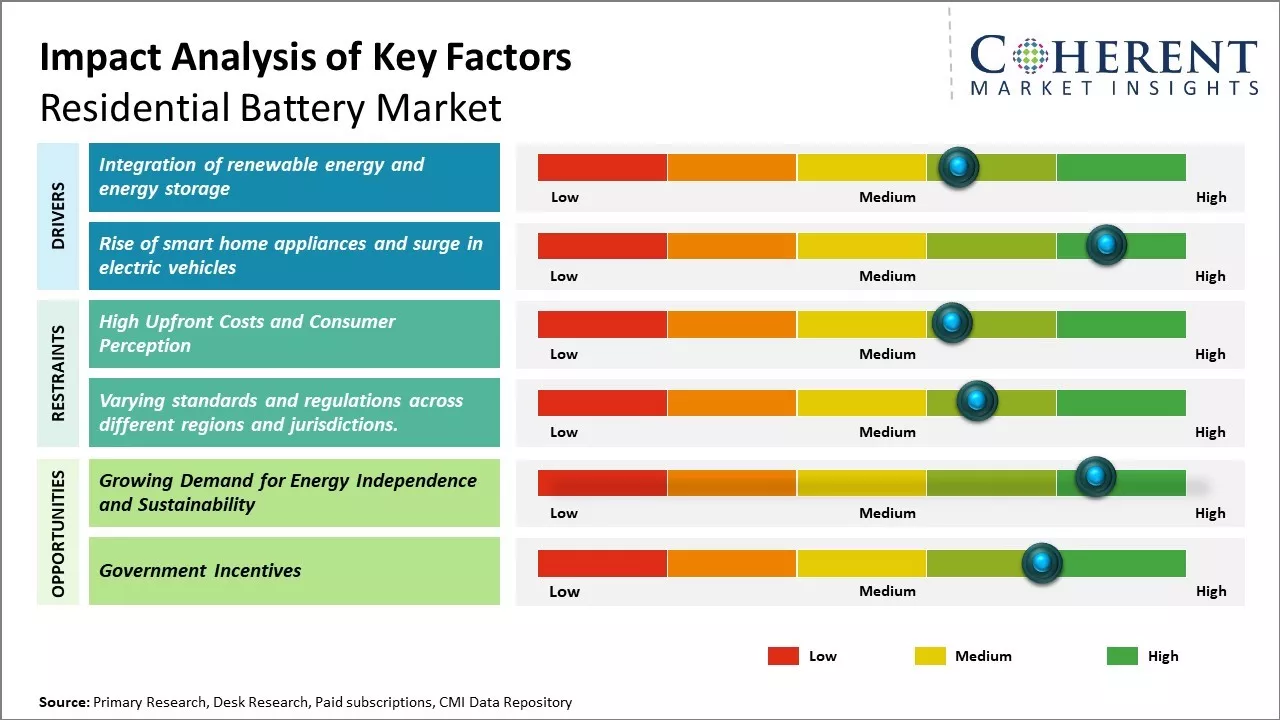
Discover market dynamics shaping the industry: Request sample copy
The growth of the residential battery market is driven by the increasing demand for green energy and grid stability. Rising electricity costs and growing awareness among homeowners regarding energy independence is also pushing the growth of localized and distributed energy storage solutions. Government regulations and policies providing incentives for battery storage installations are further encouraging the widespread adoption of residential battery systems. The deployment of residential batteries is expected to pick up pace over the coming years as their prices continue to decline and technologies improve.
Integration of renewable energy and energy storage
With growing environmental concerns and emphasis on sustainability, many countries have set ambitious renewable energy targets to transition towards cleaner sources of energy like solar and wind. Due to the intermittent nature of these renewable sources, the need for scalable and reliable energy storage to balance power fluctuations is growing. Residential battery storage absorbs excess renewable energy produced during the day, discharging it to power homes in the evening. This helps homeowners lower their carbon footprint and electricity bills by maximizing the self-consumption of on-site clean energy. Moreover, by reducing dependency on the grid during peak hours, battery storage also helps reduce stress on the overall power infrastructure. Several governments now offer substantial subsidies and tax incentives for homeowners to install rooftop solar panels integrated with battery packs. This has encouraged many environmentally conscious consumers to opt for such green home energy solutions.
For instance, in 2021, the price of lithium-ion batteries dropped to USD 123/kWh, marking an 81.58% decline from USD 668/KWh in 2013. While residential energy storage policies are still evolving, countries like the U.S. and Germany are fostering opportunities in local energy storage markets through state and regulatory actions.
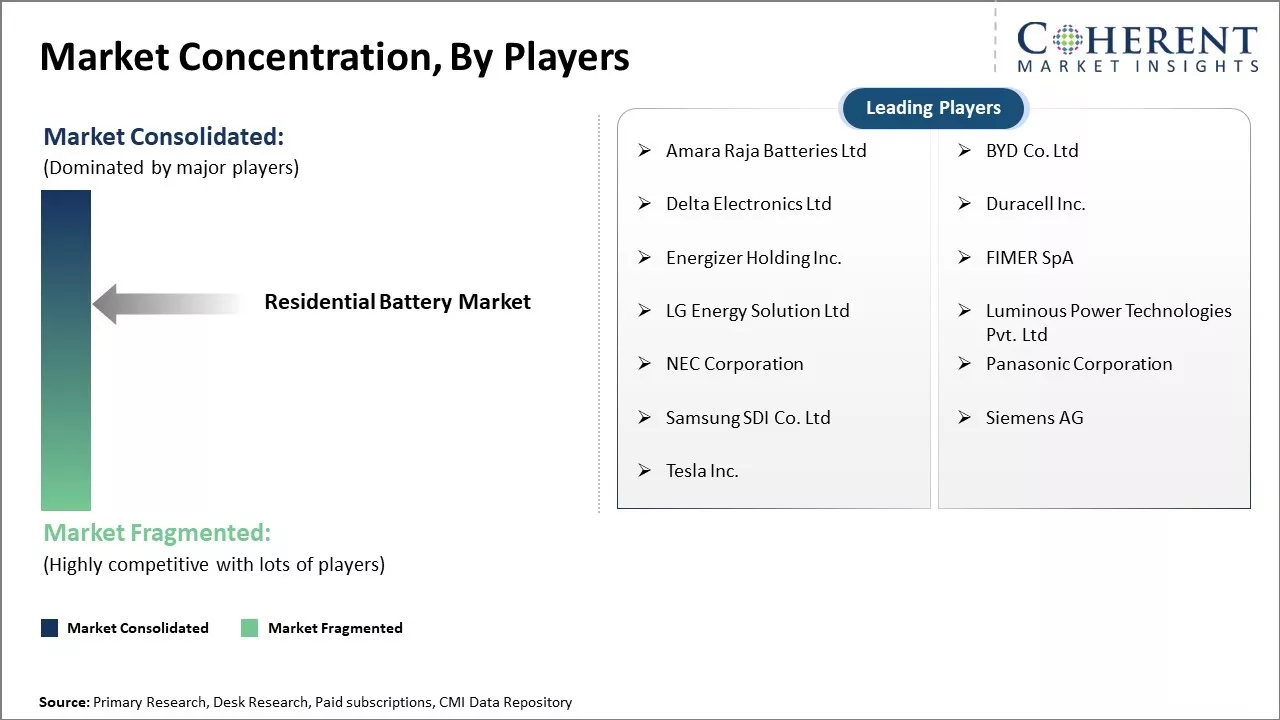
Get actionable strategies to beat competition: Request sample copy
Rise of smart home appliances and surge in electric vehiclesAlong with sustainability goals, growing digitalization of homes is another key driver for the residential battery market. The proliferation of smart appliances, automation systems, and electric vehicles that require electricity to function has increased the household power consumption manifold. However, meeting peak demand entirely from the grid can get expensive and add unnecessary loads. Here batteries play a vital supporting role by powering such devices seamlessly using stored solar or off-peak grid electricity. For example, batteries allow the convenient charging of electric vehicles at home during non-peak hours and add range assurance. They also ensure reliable backup power for critical smart home accessories like surveillance cameras, internet routers, etc. This dual capability of batteries to optimize self-consumption from rooftop panels as well as power smart homes reliably is motivating more homeowners to invest in individual battery energy storage systems.
For instance, in August 2022, Tesla partnered with Green Mountain Power (GMP) to deploy Powerwalls, Tesla’s home battery pack, in a decentralized manner alongside electric utilities. GMP, a small utility in Vermont, was among the first to adopt Tesla Powerwall.
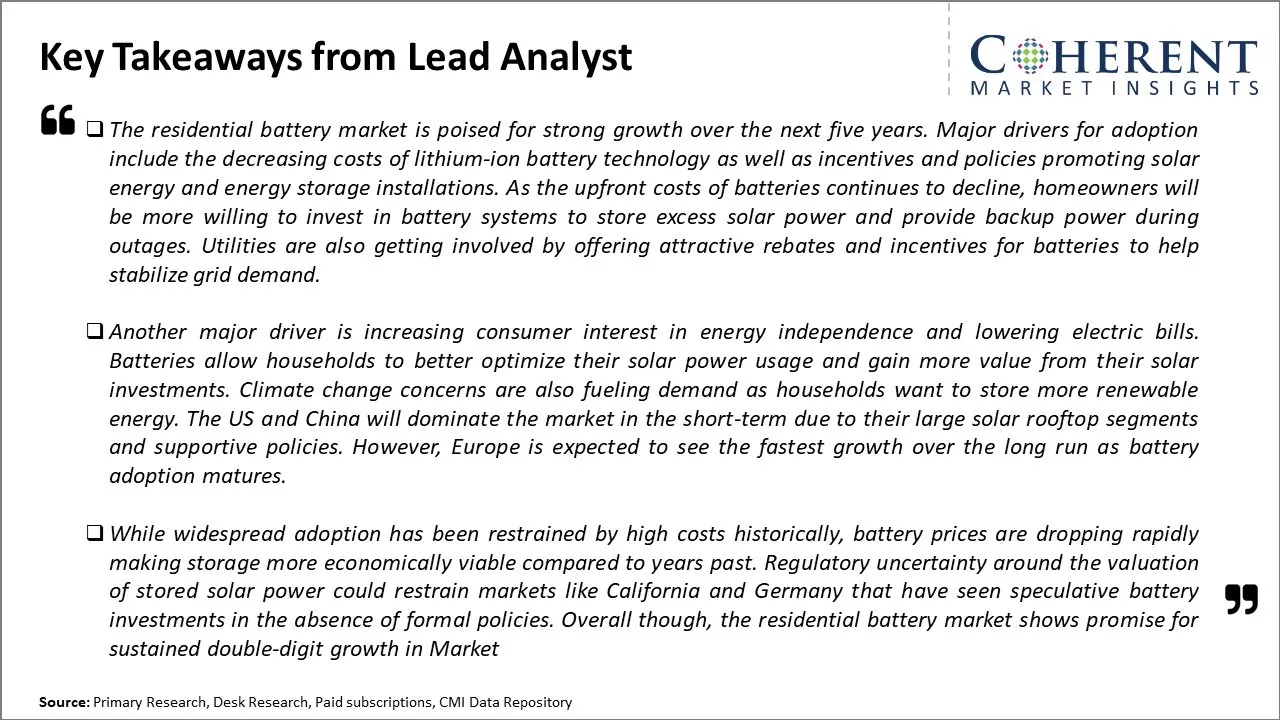
To learn more about this report, Request sample copy
Market Challenges: High Upfront Costs and Consumer PerceptionBattery technology still needs improvements to increase capacity and lifetime at a reduced cost. With prices still relatively high, consumer adoption has been slow as people weigh the high upfront costs against the long-term energy savings. Educating consumers about the benefits and ROI is difficult as concepts like power outages and energy resiliency are abstract. Standards and regulations also vary greatly across jurisdictions, adding compliance complexities for companies operating in multiple markets.
Market Opportunities: Growing Demand for Energy Independence and Sustainability
Incentives and subsidies from governments looking to expand renewable energy are helping drive down battery prices. As awareness of climate change increases, more homeowners want to store their own solar power. The growth of home energy management systems and smart home technology creates opportunities to integrate batteries into broader energy management solutions.
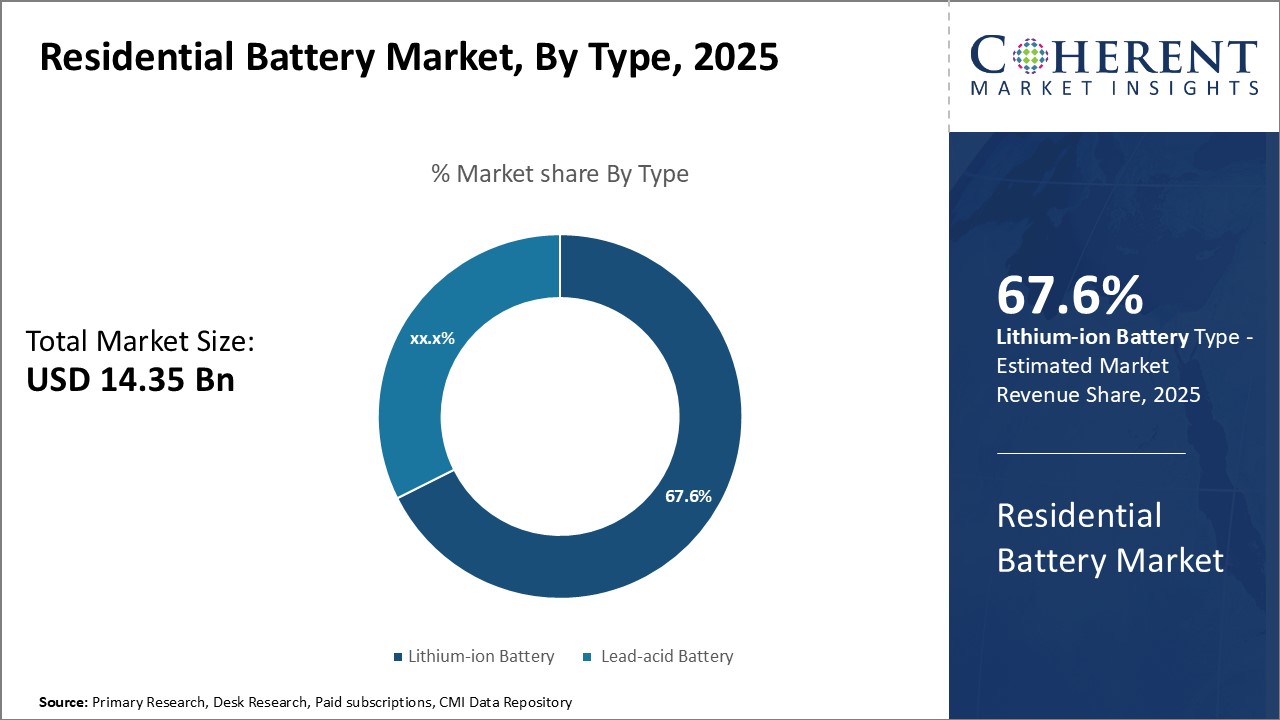
Discover high revenue pocket segments and roadmap to it: Request sample copy
Insights, By Type - Favorable Economics Drive the Lithium-ion Battery AdoptionIn terms of type, lithium-ion battery is expected to contribute the highest share of 67.6% in 2025, owing to its superior energy density and cost advantage over other battery types. Lithium-ion batteries are able to store more energy per unit weight and volume, which allows residential battery systems using lithium-ion batteries to be smaller and lighter than those using lead-acid batteries.
Additionally, the falling production costs of lithium-ion batteries in recent years have improved their cost competitiveness significantly. Manufacturers are achieving scale economies by building large battery manufacturing plants. There is also continuous technological progress that enhances energy density while reducing material usage. These factors have lowered the levelized cost of energy from lithium-ion batteries to a level that is attractive for residential applications. For consumers, lithium-ion battery systems mean lower upfront capital costs compared to alternatives.
Supportive government policies in many countries for distributed renewable energy generation and storage have further spurred the lithium-ion battery adoption. Subsidies and tax incentives make battery-based home energy storage economically viable for homeowners looking to lower their electricity bills and carbon footprint through self-consumption of rooftop solar power.
Insights, By Power Output - Mid-range Capacity Meets Diverse Energy Needs
In terms of by power output, the 6-10 kW segment is expected to contribute the highest share of 42.75% in 2025, as it offers an optimal balance between cost and application versatility. Batteries in the 6-10 kW range can effectively store excess solar power generated during the day and provide enough electricity in the evenings to power essential home appliances and lights. They offer sufficient capacity for most single-family homes.
At the same time, mid-range batteries allow economies of scale in manufacturing while having per-unit costs comparable to higher-capacity systems. They provide flexibility to later increase storage size to meet growing energy demands from electric vehicles or additional solar panels. Their flexibility makes them suitable for both new homes as well as retrofits in existing homes.
Insights, By Operation Type - Standalone Systems Lead in Independent Power Solutions
In terms of By operation type, standalone systems are expected to hold the highest share of 72.42% in 2025, as they provide a cost-effective means for residential consumers to take full control of their energy needs. Standalone batteries are an affordable solution for homes not connected to the main power grid or for those aiming to achieve energy self-sufficiency.
They allow for independent power during outages and offer insurance against rising electricity tariffs. In remote locations lacking grid access, standalone systems have become a dependable and clean alternative to diesel generators. An evolving range of power conversion equipment further boosts their efficacy.
Additionally, latest standalone batteries have achieved parity on levelized cost of energy with grid power in some nations, making them a compelling investment. Their modularity also means easy DIY installation and scalability based on load changes. This furthers the appeal of independence from centralized infrastructure.
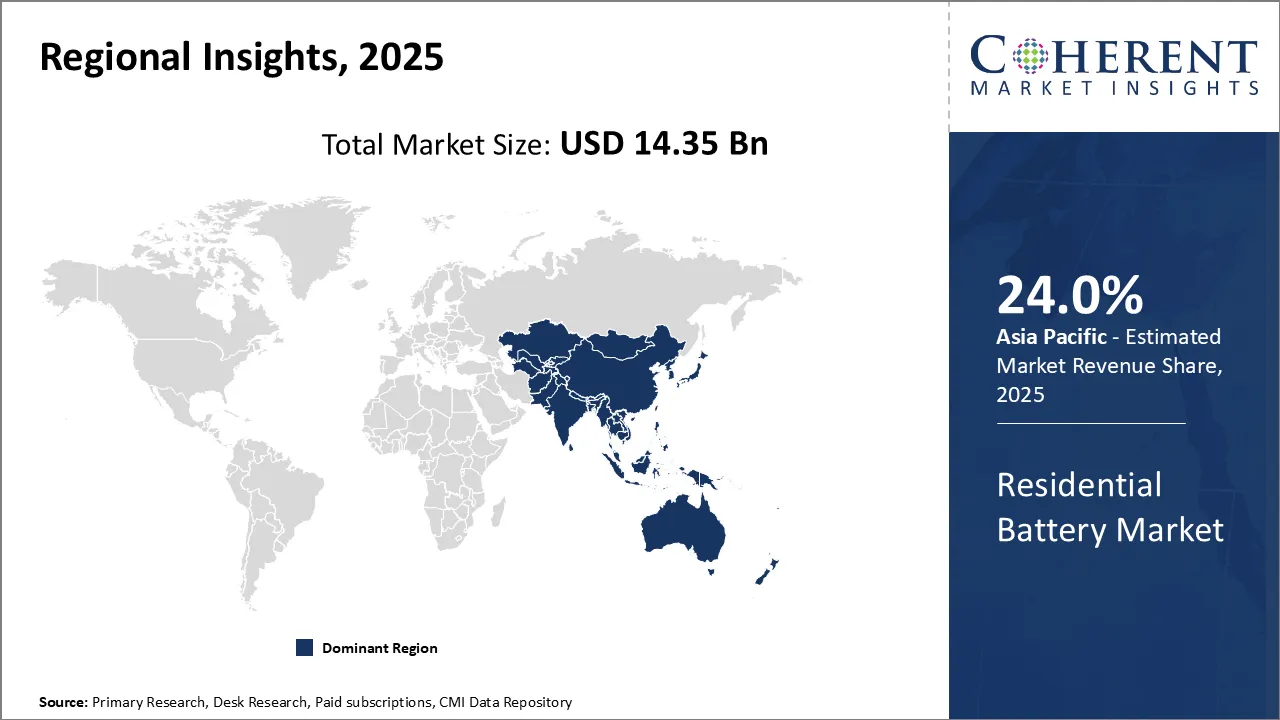
Need a Different Region or Segment? Customize now
The Asia Pacific region is poised to be the fastest growing with CAGR of 24.0% as well as dominant market with market share of 43.7% for residential batteries market in 2025. With increasing electrification across countries and rapid expansion of distributed renewable energy sources, the need for residential storage assets is rising greatly. The region hosts a few emerging battery hubs like China, South Korea, Japan, and India which are helping augment the manufacturing capabilities and supply chain requirements. Battery majors have been rapidly scaling up their localized production to cater to the ballooning regional demand. Projects involving microgrids and rural electrification relying on battery storage are further driving the APAC market.
Countries like Australia and New Zealand within the Asia Pacific region have also emerged as promising markets, though from a smaller base. Growing distributed generation incentivized by net metering and feed-in-tariff schemes have accelerated the adoption of household batteries. Battery installations are largely concentrated in off-grid rural communities and island regions that look to integrate more renewables into their energy mix. Residential battery suppliers have started exploring these countries through partnerships with local EPC players and retailers. With supportive policies and manufacturing ramp-ups underway, APAC holds immense promise for residential battery market in the coming years.
Residential Battery Market Report Coverage
| Report Coverage | Details | ||
|---|---|---|---|
| Base Year: | 2024 | Market Size in 2025: | USD 14.35 Bn |
| Historical Data for: | 2020 To 2024 | Forecast Period: | 2025 To 2032 |
| Forecast Period 2025 to 2032 CAGR: | 18.5% | 2032 Value Projection: | USD 47.12 Bn |
| Geographies covered: |
|
||
| Segments covered: |
|
||
| Companies covered: |
Amara Raja Batteries Ltd, BYD Co. Ltd, Delta Electronics Ltd, Duracell Inc., Energizer Holding Inc., FIMER SpA, LG Energy Solution Ltd, Luminous Power Technologies Pvt. Ltd, NEC Corporation, Panasonic Corporation, Samsung SDI Co. Ltd, Siemens AG, and Tesla Inc. |
||
| Growth Drivers: |
|
||
| Restraints & Challenges: |
|
||
Uncover macros and micros vetted on 75+ parameters: Get instant access to report
Share
Share
About Author
As an accomplished Senior Consultant with 7+ years of experience, Pooja Tayade has a proven track record in devising and implementing data and strategy consulting across various industries. She specializes in market research, competitive analysis, primary insights, and market estimation. She excels in strategic advisory, delivering data-driven insights to help clients navigate market complexities, optimize entry strategies, and achieve sustainable growth.
Missing comfort of reading report in your local language? Find your preferred language :
Transform your Strategy with Exclusive Trending Reports :
Frequently Asked Questions
Joining thousands of companies around the world committed to making the Excellent Business Solutions.
View All Our Clients
US Reciprocal Tax Impact Analysis On Residential Battery Market
Stay updated on tariff changes with expert insights and timely information